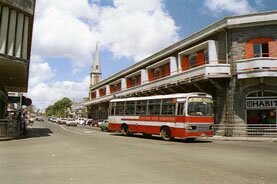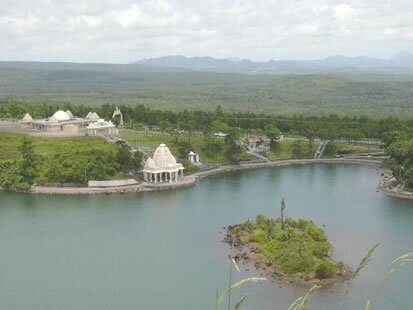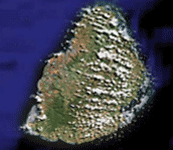
|
 |
|||||||||||
|
|
|
|
|
|
|
|||||||
|
Mauritius information
|
|
ACCOMMODATION
|
RESTAURANTS
|
NIGHTLIFE
|
EXCURSIONS
|
VISIT
|
DRIVE
|
|
|
Mauritius Information Central Region
The reputation of Mauritius for its beaches and sea is now established and Mauritius remains first of all a "sea sun & sand" destination. Since several years, there is a will to promote the country as a whole for its nation and fauna as well as for its inland regions. Many are those who are astonished by their discovery of the island's inner regions wondering why they had not been briefed about this aspect of Mauritius.
Since the beginning of this century the inner regions are more easily accessible as: - There are some magnificent private properties that are now being commercialised and accessible to visitors through guided hikes, mountain biking or Quad rides. - It is now possible to find excellent accommodation in lodges and guesthouses inland. |
|
Climate
The climate in the centre of the island is totally different to the coastal regions as the centre part is higher in altitude. It is therefore generally cooler, especially after sunset and simply cold in winter in the highest parts (around Curepipe). Temperature may vary between 12-degree Celsius and 22-degree Celsius in winter or between 18-degree Celsius and 30-degree Celsius in summer but this is just a numerical indication as due to the high humidity (up to 90%) the extremes in temperature are amplified.
|
|
Topography
It is difficult to describe the topography of the centre as it covers a large part of the island. However, all the sub regions of the centre may have one thing in common; it is always sloping up or down and in altitude. The vegetation is much richer than the coasts and often free of sugar canes. The different lakes and reservoirs give a more continental atmosphere. |
|
Town and Villages
The most important residential towns of Mauritius are found on the high lands. Although they are not very pleasant to the eyesight, visiting them allows the discovery of the day-to-day life of Mauritius, although it could be seen as a visit to "the dark side of the moon."
 Curepipe CurepipeCurepipe is almost in the middle of Mauritius where the climate is rather cool, very humid and rainy almost all year round. The sky is grey and the buildings are all dark grey from mildew. Avoid Curepipe and keep a better image on Mauritius. Beau Bassin / Rose Hill If you have some extra time, the town of Beau-Bassin / Rose-Hill are a better detour. Rose-Hill came to life at the end of the 18th century when the malaria disease was spreading in Port-Louis. People moved their residences to the higher plains where the cooler climate was keeping most mosquitoes away. Rose-Hill and Beau Bassin were then the new places to be and until the mid 1900's Rose Hill and especially Beau-Bassin had plenty of wonderful colonial houses. Owing to the quality of the earth and the humidity the huge gardens around these well-kept houses were simply magnificent. Today, Beau-Bassin / Rose-Hill is just another busy town of Mauritius with very few of these luxuriant properties. However, it takes its charm from being by far the largest residential town of Mauritius inhabited by all ethnics, which we can qualify as the true Mauritians. Rose-Hill is full of funny shops, visited by all, especially the young ones. We suggest to park in the centre and have a stroll in "Arabtown" and around the fair. Quatre-Bornes This town is adjacent to Beau-Bassin / Rose-Hill and is slightly more organised and "modern." Its main attraction is its fair, which by the way occurs namely on Sundays, the ideal day as the beaches are crowded. Although the above does not make these towns very attractive, we recommend allowing them a few hours especially due to the fact that they are close to the Plaine Champagne to Chamarel road, which is highly recommended. Our favourite village: Chamarel Chamarel is unique as it is the only typical remote mountain village of Mauritius. Quiet, pretty and tidy, Chamarel successfully merges with its surrounding vegetation. Populated by the Creole community of Mauritius, Chamarel is the nursery of this culture and is the place from which most of the Sega songs were written, sang and danced. Traditional but not conservative, the people of Chamarel successfully separated the wheat from the chaff of evolution. Warm, friendly with a deep sense of hospitality, the people of Chamarel have welcomed visitors and tourists since decades but contrarily to inhabitants of other regions, they managed to remain authentic. The yearly Fancy Fair of Chamarel remains the most important event of the region and an occasion for its people to proudly share with others, the specialities of the village, namely the "Curry No. 1" (monkey curry). Otherwise, it is the Sunday mass that makes the event. Too much tourism kills tourism... What is described above still holds true but owing to its success as one of the last "authentic" villages, Chamarel is today an example of over-exploitation. Several restaurants and so-called "tables d'hotes" have open along the way in an atmosphere of fierce, unethical competition. Flags, signs and people are placed all along the road almost "ordering" the cars to stop in each restaurant. Big commissions business going on, money flowing to drivers of cars, taxis and minibuses, recommending their passengers the addresses that pay the most... Only one or two don't play that ball and they of course serve the most authentic and delicious creole food; they are easy to find, just ask your driver which restaurant they would NOT recommend... |
|
To see and do
Chamarel Road There are three ways to access Chamarel, but for the view, we recommend to start form the heights (Plaine Champagne road) and drive towards the coast. The rich and wild vegetation along the road changes every kilometre as you drive. It is often cold and rainy uphill to become sunny and warm after just ten kilometres. There are several places along the road where you can stop for a snapshot, a walk in the woods or to waterfalls, for a visit to the village or for lunch at one of the "table d'hotes" along the street. This drive is a must and is the most convenient way to take you from the centre of the island to the south or west coasts.
Grand Bassin
 Grand Bassin is part of the itinerary of the excursions proposed along the high plateau. The call is interesting for its legend; the water inside the crater is said to be in direct contact with the waters of the holly Ganges of India. The Hindus of Mauritius have thus declared Grand Bassin as the holiest and sacred place of Mauritius. A Pilgrimage occurring every year on the Occasion of the "Maha Shivaratree" festival leads tens of thousands of people to Grand Bassin, contributing to this mystical atmosphere. A huge statue of Shiva has been erected on the spot. The best way to go round the high grounds routes is to rent a car or hire a taxi for the day but there are also excursions in minibuses or in a chauffeur-driven car. Le Pouce For those who wish to hike in open nature independently from guides and tours, the "Le Pouce" mountain is the right thing to do. It is relatively easy to climb except for the last 50 metres, and the view from the top is of course fantastic as almost the whole island can be seen from there. The easiest way to start off is to park at its foot in the area of Moka. (Follow the signs to Eureka House, then the ones to Le Pouce). It is recommended not to leave any valuables in the car and the ascent is probably not adequate to children below 10 years.
Exportal Ltd
Email:
Phone: +230 5421 1070
Royal Road, Haute Rive
Rivière du Rempart, Mauritius
By Bernard Cayeux
Update January 2013
|

Home | Accommodation | Restaurants Bars and Clubs | Tours and Excursions | Car Rental | Shops and Services | Travel to Mauritius
Mauritius Information | Images of Mauritius | Mauritius Map | RSS Feeds | Sitemap | Contact us | About us
Advertise with us | General Conditions | Tourism | Holidays | Destinations | Travel | Vacations | Villas Rentals
© Copyright 2008-2015, All rights reserved.
Mauritius Information | Images of Mauritius | Mauritius Map | RSS Feeds | Sitemap | Contact us | About us
Advertise with us | General Conditions | Tourism | Holidays | Destinations | Travel | Vacations | Villas Rentals
| Tweet | Follow @tropicscope |
© Copyright 2008-2015, All rights reserved.







